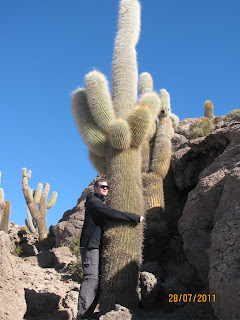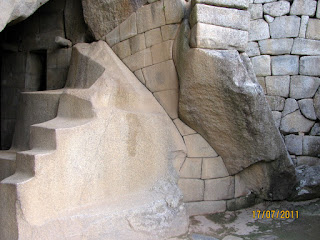We stupidly listened to a travel agent who told us not to book the tickets (which were a fraction of the price) at the bus terminal because those companies had poor quality buses. Instead we got ripped off and thrown on a bus with rattling windows right next to a door that didn´t seal. It got so cold that the windows were thickly iced over by dawn. Had we not been lied to about the lack of heating we may just have pulled our sleeping bags out.
 At dawn we were unceremoniously dumped on the side of the road in the bleak Vegas style dump of Uyuni, where it must have been about -10. We had nothing booked, and our arms were clawed at by touts trying to sell us tours, but strangely no offers of accommodation. Some touts offered rooms and dragged travellers to the hotels, only to discover that there was nothing available.
At dawn we were unceremoniously dumped on the side of the road in the bleak Vegas style dump of Uyuni, where it must have been about -10. We had nothing booked, and our arms were clawed at by touts trying to sell us tours, but strangely no offers of accommodation. Some touts offered rooms and dragged travellers to the hotels, only to discover that there was nothing available.Heating is absolutely non-existent in Uyuni - even the Canadians and Swiss people we met were complaining about the cold. We did a couple of laps of the town centre before stumbling on the aptly named "Palace Hotel," a concrete construction with absolutely no heating. It boasted an infamous Latin American suicide shower, where the shower head is wired up and electrified and it is really easy to give yourself an electric shock, but sometimes hard to regulate the water temperature and actually get a hot shower.
 But staying in this freezing concrete town wasn´t all in vain - we were here to visit the amazing Uyuni salt lake, 12,000 square kilometres of blinding salt-encrusted whiteness. Its safe to say that there is nothing else in the world that looks quite like it. Once lying on the bottom of the ocean, it was shoved 4km above sea level thousands of years ago and its location on the harsh Andean high plain adds to the visual spectacle, complete with fossilised pre-historic fish and coral.
But staying in this freezing concrete town wasn´t all in vain - we were here to visit the amazing Uyuni salt lake, 12,000 square kilometres of blinding salt-encrusted whiteness. Its safe to say that there is nothing else in the world that looks quite like it. Once lying on the bottom of the ocean, it was shoved 4km above sea level thousands of years ago and its location on the harsh Andean high plain adds to the visual spectacle, complete with fossilised pre-historic fish and coral. Salt flat tours are a little predictable, with most agencies stopping off at the same sights along the way, including the salt refinery, a curious rust-heap of old steam train carriages, a building made of salt bricks and a cactus-studded island. Everything was amazing, but each time our 4WD Land Cruiser stopped, we were barked at to get out, take photos and shoehorned back in quickly, sometimes too quickly to really take in the incredible landscape. Our theory is that the quicker our driver got us through the attractions and to our sleeping stop at the end of the day, the more downtime he got.
Just driving across the blindingly white expanse was an experience in itself, especially in a part where it had recently rained, so the mountainous backdrop was mirrored back onto the salt flat. But the most surprising part of the day was the potential for taking ludicrously stupid photos, playing on the flatness of the landscape and its monotone colour. It was so easy - just put an object such as a wine bottle in the foreground of the shot, lie flat on the salt flat and put the camera as close to the ground as possible, and have the other person stand further away so that it would look like a minature version of them standing on the object. The results, as you can see, had us in stitches.
We continued further south along the bleak, rocky high plain, which became increasingly chilly. Snow covered volcanoes appeared and the already scrubby vegetation disappeared. It had snowed recently, and part of the track we drove along had snow banks piled high on either side. Most lakes we passed, which normally boasted bright colours, were frozen over.
 By now we had reached the very southern tip of Bolivia, a national park bordering Chile and Argentina. The jewel of this area is the Laguna Colorada, an immense rust coloured expanse of near-freezing water that lay in front of a row of imposing snow-flecked mountains. Incongruously, it is home to a colony of flamingos that feed on naturally occurring krill in the lake, which gives it its red colour, and in turn colours the birds´ feathers. A real case of you are what you eat!
By now we had reached the very southern tip of Bolivia, a national park bordering Chile and Argentina. The jewel of this area is the Laguna Colorada, an immense rust coloured expanse of near-freezing water that lay in front of a row of imposing snow-flecked mountains. Incongruously, it is home to a colony of flamingos that feed on naturally occurring krill in the lake, which gives it its red colour, and in turn colours the birds´ feathers. A real case of you are what you eat!We tried to enjoy the serenity, but by this time the sun had set behind the mountains and the wind was howling, and besides the flamingos were proving extremely difficult to photograph. The numerous frozen flamingo corpses lining the lake shores were a telling sign that we shouldn´t hang around too long!
 |
| Laguna Colorada |
The final day of our tour involved a brief stop at the Chilean border, in a super-remote part of the Atacama desert that was knee-deep in snow. Finally it was time to drive back up to Uyuni, which now seemed like a pumping metropolis compared to the remote Bolivian altiplano, but we did manage to squeeze in a visit to some extremely steamy geysers with bubbling mud and a breakfast swim in some thermal springs. It was surreal to be sitting in a hot bath with snow and ice just metres away in the frozen lake.
 |
| Warming the vino on the crappy stove |
After this schlep our next aim is to escape the cold on a heated (we hope!) night train up north, where we will descend a few thousand metres - and the beer will not be so stupidly fizzy when poured out of the bottle. Next stop; the mediterranean climate of Cochabamba.
















